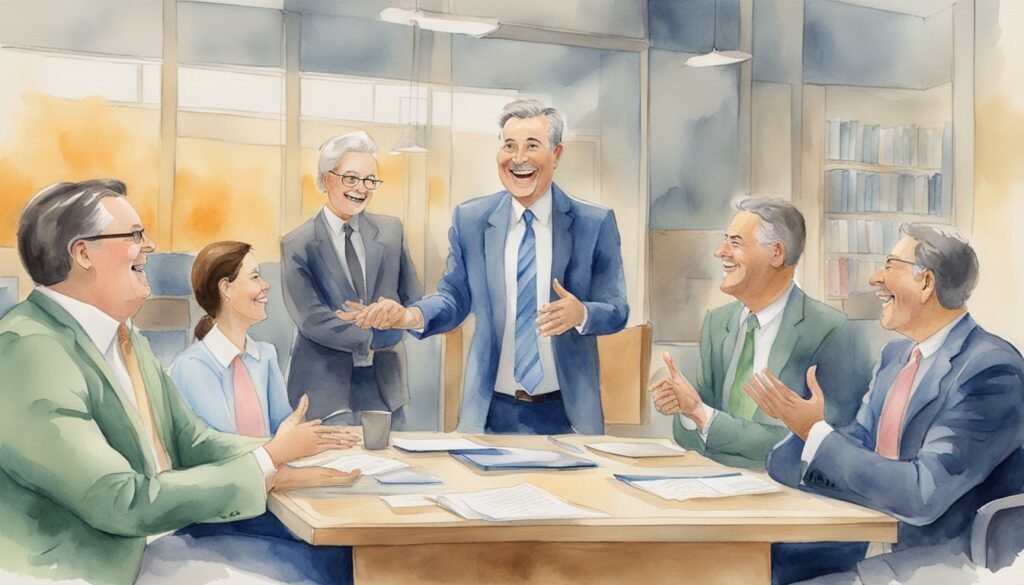Humor in the workplace is often seen as a key to effective leadership. A well-timed joke can lighten the mood, ease tensions, and foster a more enjoyable work environment.
But a recent study published in the Academy of Management Journal reveals that frequent humor from leaders can have unintended negative consequences.
The study, “Faking It with the Boss’s Jokes? Leader Humor Quantity, Follower Surface Acting, and Power Distance,” was written by researchers Xiaoran Hu, Michael R. Parke, Randall S. Peterson, and Grace M. Simon of the London School of Economics and the University of Pennsylvania, and was published on January 22, 2024.
Their findings show that while humor can be beneficial, overusing it can lead to emotional exhaustion and decreased job satisfaction among employees.
Understanding the Study
The researchers aimed to differentiate between the quantity and quality of leader humor and explore its emotional costs. They focused on “surface acting,” where employees feel compelled to display positive emotions that they do not genuinely feel. This behavior can be especially taxing in workplaces with high “power distance,” where hierarchical relationships are pronounced, and employees feel a stronger need to conform to their leaders’ expectations.
Methodology
The research was conducted through three comprehensive studies: a field experiment, a laboratory experiment, and a multi-wave field study. Each provided unique insights into the impact of leader humor on employees.
The first study involved 100 part-time professional degree students who were also managers, along with one of their subordinates. These managers were recruited from a large research university in Southern China and were part of a semester-long leadership course. The managers were randomly assigned to one of two groups: a humor intervention group or a control group. Those in the humor intervention group were instructed to incorporate more humor into their interactions for one week.
The humor intervention group received specific instructions to engage more frequently in humor expression, such as telling amusing stories or making jokes. For instance, a manager might start a meeting with a light-hearted joke like, “Why don’t scientists trust atoms? Because they make up everything!” These instructions were intended to make the humor intervention group’s workplace interactions more humorous than those in the control group.
After one week, the subordinates of these managers reported their levels of surface acting, emotional exhaustion, and job satisfaction. The results showed that leaders in the humor intervention group used humor significantly more frequently, which led to higher surface acting among employees. Specifically, the increased humor leves led to more surface acting, with scores of 2.15 versus 1.72 in the control group.
Laboratory Experiment: Controlled Conditions
To further explore these findings, the researchers conducted a laboratory experiment involving 198 participants divided into small groups. These participants, a mix of university students and local employees from a business school in the northeastern United States, participated in a mock focus group led by a professional actor trained to deliver scripted humor. The setting was designed to mimic real-world interactions but with controlled conditions.
Participants were assigned to either a high humor frequency group or a low humor frequency group. The actor leading the high humor frequency group incorporated frequent jokes and humorous remarks, such as puns and playful comments. For example, during the discussion, the actor might say, “I told my wife she was drawing her eyebrows too high — she looked surprised!”
In addition to humor frequency, the researchers manipulated power distance by altering the perceived hierarchy between the group leader and participants. In high power distance groups, the leader wore formal attire and emphasized his authority, instructing participants to respect their leadership. In low power distance groups, the leader dressed casually and encouraged a more egalitarian interaction, treating participants as equals.
The results confirmed that frequent humor increased surface acting, particularly in high power distance settings. Participants in the high humor frequency condition reported more surface acting (average score of 3.12) compared to those in the low humor frequency condition (average score of 2.28). This surface acting led to greater emotional exhaustion and lower job satisfaction.
Multi-Wave Field Study: Long-Term Effects
The final part of the research involved a multi-wave field study tracking employees over several weeks. This study aimed to observe the long-term effects of leader humor on employees’ well-being. Employees from various organizations were surveyed at multiple points to assess changes in their emotional exhaustion and job satisfaction over time.
Employees who reported higher frequencies of leader humor initially also reported increased surface acting, which persisted over time. This ongoing surface acting contributed to chronic emotional exhaustion and a steady decline in job satisfaction. The longitudinal data confirmed that the negative effects of frequent leader humor were not short-lived but had lasting impacts on employee well-being.
Implications for the Workplace
While humor can sometimes create a more pleasant work environment, this study highlights the potential pitfalls of overusing it. Leaders need to be mindful of the frequency of their jokes and the pressure it can place on employees to respond positively.
Organizations might need to rethink their approach to encouraging humor in the workplace. It’s essential for leaders to balance their use of humor, ensuring it remains a tool for genuine connection rather than a source of stress. Leaders should also consider the individual differences among employees, particularly in environments with high power distance, where the pressure to conform is greater.

Future Research Directions
The study opens up several avenues for further research. Future investigations could explore how different types of humor—such as self-deprecating versus sarcastic humor—affect employee well-being. Additionally, examining cultural differences in humor perception and response could provide deeper insights into managing a diverse workforce.
Further research could also look into the interplay between humor quantity and quality. Understanding how genuinely funny leaders, who use humor frequently, impact employee well-being could offer more nuanced guidelines for leadership practices.
Conclusion
While a well-timed joke can be a powerful tool for leaders, this study underscores the need for a balanced approach. Overusing humor can have significant emotional costs for employees, leading to increased emotional exhaustion and decreased job satisfaction. Leaders must navigate the fine line between fostering a positive atmosphere and avoiding the unintended consequences of frequent humor. By understanding the complex dynamics of leader humor, organizations can better support employee well-being and create a more authentic and enjoyable work environment.

